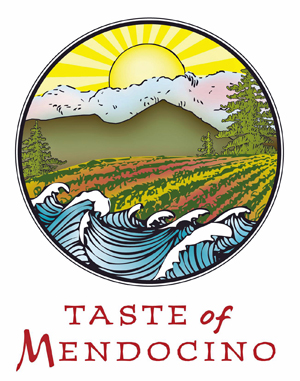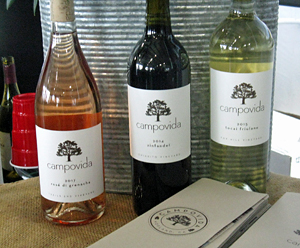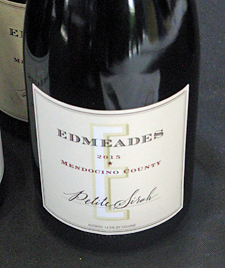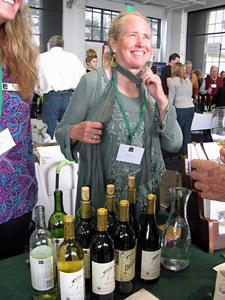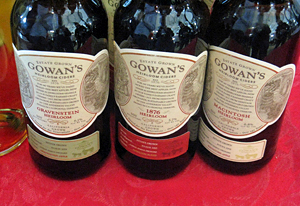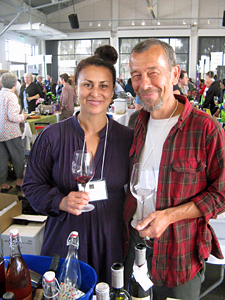Barra of Mendocino Wines / Girasole Vineyards
Charlie Barra is a legendary grower in Redwood Valley, where he started farming his estate vineyard in 1955. The Barra wine label was established in 1997. All of the fruit for the Barra wines and for sister label Girasole comes from the certified organic estate vineyard. The Barra 2016 Pinot Noir Rosé was one of my favorites at the winery table – this had beautiful floral aromatics plus strawberry, spice, along with fine acidity on the palate. The Girasole 2016 “Hybrid Red” – a Merlot-based blend that also includes Cabernet Sauvignon, Sangiovese, and Petite Sirah – was also noteworthy. A bright, lighter-weight red displaying dark berry fruit, herbs, a touch of vanilla/oak, and plenty of structure with a firm tannic finish.
Bee Hunter Wine
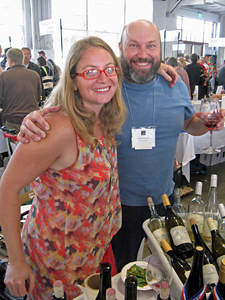 |
Bee Hunter is a fairly new label, run by Alisa Nemo (her official title is Queen Bee!) and winemaker Andre DuVigneaud. They’re based in Philo and they work with fruit mainly from the Anderson Valley, Mendocino Ridge, and Yorkville Highlands regions of Mendocino County. Both Alisa and Andre were behind the table to pour their wines at the tasting. I tasted a couple of their 2015 Sauvignon Blancs and my favorite was the 2015 Mariah Vineyard Sauvignon Blanc, from Mendocino Ridge. This showed lots of bright citrus fruit along with a restrained herbal character, vibrant acidity, and a clean finish. The 2015 Sémillon from Yorkville Highlands was a highlight, featuring melon and fig notes with more body and a creamy texture along with a long, lively finish. The 2016 Mariah Vineyard Chardonnay was made in stainless steel and neutral oak, and had a zingy lemon character with medium weight and a crisp finish. I tasted two Pinots from the Comptche area a few miles north of Anderson Valley – the 2014 Oppenlander Vineyard Pinot Noir was good, with lots of spice, somewhat higher-toned fruit, and plenty of structure, but my favorite was the 2015 Docker Hill Vineyard Pinot Noir. This one displayed earthy, spicy black cherry fruit, tea leaf and forest floor notes, with good structure and fine tannins on the finish. A nice line-up of wines from Bee Hunter.
Campovida
Owners Gary Breen and Anna Beuselinck established this new venture (first vintage in 2012) in Hopland, at the site that had been the Fetzer Wine Hospitality Center. They run a family-owned farm and vineyard, and their winemaker is Adam Johnson. I particularly enjoyed two of the Campovida wines I tasted. The 2017 Rosé di Grenache, from Trails End Vineyard in Potter Valley, spent 12-24 hours on the skins before being pressed, then aged in stainless steel and neutral oak. This displayed bright strawberry, herbs, and a hint of flowers on the nose, with a lively mouthfeel and a slightly chalky finish. Another favorite was the 2014 Zinfandel from head-pruned, dry-farmed vines at Chiarito Vineyard, in the Ukiah area. Aged in older barrels, this had ripe and bold berry fruit, lots of spice, and a chalky mineral finish – a big Zin but not jammy.
Edmeades Winery
Dr. Donald Edmeades planted the first post-Prohibition commercial vineyard in Anderson Valley in 1963, and the Edmeades label was launched in 1972. Long-known for its Zinfandels, the winery has been owned by Jackson Family Wines since 1988. Ben Salazar has been the Edmeades winemaker since 2012. Edmeades poured two wines at the tasting and both were good. My favorite was the 2014 Mendocino County Zinfandel – this is 77% Zin along with Syrah and Petite Sirah in the blend, and is sourced mainly from vineyards in Redwood Valley and Potter Valley. A lighter Zin with boysenberry, spice, pepper, a touch of vanilla, and a stony mineral note, this had a bright, medium-bodied mouthfeel and fine tannins. The 2015 Mendocino County Petite Sirah was in a lighter style for the variety as well, and featured dark berry fruit, loads of black pepper, plus vanilla and floral undertones, with good structure and firm tannins on the finish.
Fathers + Daughters Cellars
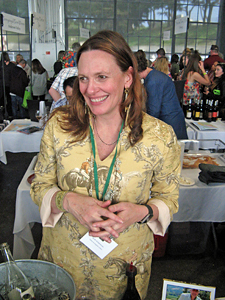 |
Fathers + Daughters is a fairly new venture, with the first vintage coming in 2012. It’s a three-generation collaboration between Kurt Schoeneman (owner of Anderson Valley’s well-known Ferrington Vineyard), his daughter Sarah and her husband Guy Pacurar, their young daughter Ella, and Guy’s older daughter Taylor. All of the fruit for the label’s wines come from Ferrington Vineyard, and noted vintner Phil Baxter heads up the winemaking. Sarah was behind the winery table at the tasting, and I particularly liked two of the wines I tried. The 2017 “Sarah’s Rustic Bubbles” is a sparkling Chardonnay made by the pétillant-naturel (pét-nat) method – not unlike a pear cider in character, this was lightly sparkling and quite refreshing. The 2016 “The Dance” – a blend of Chardonnay, Sauvignon Blanc, and Gewürztraminer – was a standout. The Gewürztraminer component was prominent in the aromatics but the herbal character of the Sauvignon Blanc also came through along with citrus, stone fruit, and flowers, with medium weight on the palate and a vibrant mouthfeel and finish..
Frey Vineyards
Paul and Beba Frey first planted their Redwood Valley ranch with winegrapes in the late 1960s. They and their family have been among the pioneers of organic (and later biodynamic) viticulture in California, and Frey was the country’s first producer of certified organic wines. All of the Frey wines are labeled as organic and contain no added sulfites. Katerina Frey was pouring the wines at the event. The 2015 “Biodynamic” Zinfandel was pleasant, in a lighter style with plenty of spice on the nose and milder tannins. But easily my favorite of the Frey wines was the 2016 Malbec – this was floral and peppery with dark berry fruit, lively acidity, and surprisingly tame tannins.
Gowan’s Hard Cider
As I did at my previous Taste of Mendocino event, I took a short break from wines and checked out the Gowan’s Hard Cider table. Sharon Gowan’s family has farmed their land near Philo for 140 years, where they grow over 80 heirloom apple varieties. They’ve only recently started producing their own hard apple ciders. All of the ciders that I tasted were very nice, with two standouts. The “1876 Heirloom Cuvée” sparkling cider – named for the year the family established their orchard in Anderson Valley – includes 13 varieties of apples and showed good complexity, with apple, pear, and stone fruit aromas, in a bright and lightly sparkling style. The “Gravenstein Heirloom” sparkling cider had more focused tart apple and citrus character and a crisp, refreshing finish.
Greenwood Ridge Vineyards
One of the oldest Pinot producers in the area, Greenwood Ridge was founded in 1980 by vintner Allan Green. The estate vineyard, in the Mendocino Ridge appellation, is at about 1,400-foot elevation off of Philo-Greenwood Road, just six miles from the ocean. Their distinctive octagonal tasting room near Philo in Anderson Valley is something of a landmark. The winery was purchased in 2016 by Ken and Diane Wilson of Wilson Artisan Wineries, and Victoria Wilson is the winemaker. The 2016 Estate Riesling was my favorite of the Greenwood Ridge wines I tasted, with stone fruit, citrus, and subtle petrol aromas, medium-light body, and a long finish. The 2016 Reserve Zinfandel was also nice, medium-bodied with spice, mocha, and herb notes with a fairly rich mouthfeel.
Handley Cellars
Founded in 1982 by Milla Handley, the estate vineyard near the small town of Navarro in the Deep End of Anderson Valley has been certified organic since 2005. A second estate vineyard is 7-acre RSM Vineyard, planted from 1999-2001. Milla announced her retirement in June 2017 – her daughters, Lulu McClellan and Megan Handley Warren, are taking over management of the winery. The 2015 Chardonnay was pleasant, with pear and earth aromas and a creamy yet lively texture. The earthy and spicy 2015 RSM Vineyard Pinot Noir showed good potential but really needs more time, while the 2015 Anderson Valley Pinot Noir, sourced from five vineyards in the Boonville and Navarro areas, is ready to go right now – black cherry, tea leaf, spice, and a touch of flowers, with medium-light body and nice acidity. This was my favorite of the Handley wines I tried and one of the best Pinots at the tasting.
Harmonique Wine
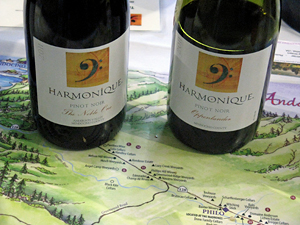 |
A partnership between Bruce Conzelman and Claudia Springs’ Bob Klindt, Harmonique specializes in Chardonnay and Pinot Noir. Both the Klindt and Conzelman vineyards are located in the cooler “deep end” of Anderson Valley. The first Harmonique Pinots were from the 2002 vintage. Pinots are held back for release longer than at most wineries, so their current Pinots are from the 2011 vintage. I thought three of the Harmonique wines I tried were noteworthy. The 2011 “Delicacé” Pinot Noir was a lighter, earthier style with herbs, smoke, and forest floor notes upfront and black cherry fruit in support. The 2011 “The Noble One” Pinot Noir was a bolder rendition of the variety, showing cherry, spice, and a touch of vanilla/oak on the nose, with more structure and a firm finish. Best of all was the 2011 Oppenlander Vineyard Pinot Noir, which featured bright red fruit, exotic spices, and a stony mineral component along with fine acidity and a long finish – very intriguing now and should continue to age nicely.
|
Husch Vineyards
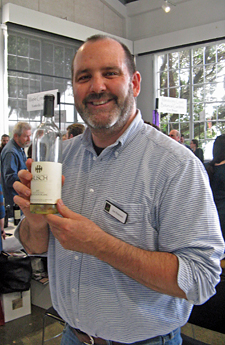 |
Located between Philo and Navarro, Husch is the oldest winery in Anderson Valley – it was established by Tony and Gretchen Husch in 1971. The winery has been owned by the Oswald family since 1979. The current proprietors, Zac Robinson and Amanda Robinson Holstine, are the third generation of the Oswald family at Husch, and Brad Holstine heads up the winemaking team. Zac Robinson was on hand to pour the Husch wines, and all of the ones I tasted were standouts. The 2017 Sauvignon Blanc – bottled the day before the tasting! – had bright herbal and gooseberry scents, with lively acidity and a fresh finish. Gewürztraminer from Anderson Valley tends to be among the best from California, and the 2016 Gewürztraminer was a fine example of the variety, with floral, spice, and citrus aromas and medium weight on the palate. The 2014 “Knoll” Pinot Noir includes fruit from Anderson Valley’s first planting of Pinot Noir in 1971, and displayed black cherry and plum fruit, earth, and tea leaf notes, with plenty of structure for aging. I finished with the 2014 Cabernet Sauvignon, sourced from the Ukiah Valley area. This was a lighter style of Cabernet, with bright herbal aromas along with plum and darker fruit and touches of spice and vanilla, a lively texture with a stony mineral note, and moderate tannins. A strong line-up from Husch.
Lazy Creek Vineyards
Dating back to 1973, Lazy Creek is one of Anderson Valley’s oldest wineries. Don and Rhonda Carano (of Ferrari-Carano in Dry Creek Valley) purchased Lazy Creek in 2008. The estate vineyards are planted entirely to Gewürztraminer and Pinot Noir. Christy Ackerman has headed up the Lazy Creek winemaking team since 2008. My favorite of the wines I tried at the tasting was the 2017 Rosé of Pinot Noir – this had floral and fresh red fruit aromas, with a bright, clean mouthfeel and finish.
Murder Ridge Winery
Murder Ridge is run by proprietors Leslie Sisneros and Steve Alden. Leslie has been the winemaker for several noted Sonoma County producers over the years, while Steve owns Perli Vineyard in the remote Mendocino Ridge AVA between Anderson Valley and the Pacific coast. The area is particularly known for Zinfandel and Pinot Noir, and those varieties are the focus at Murder Ridge. The 2015 Perli Vineyard Pinot Noir was pleasant, with cherry and floral notes, medium weight, and a lively finish. Even better was the 2014 “Wildlands” Zinfandel, sourced from Perli and other vineyards in the area – this was a lighter-style Zin, with red fruit, earth, spice, and a lingering finish. I thought the 2015 Perli Vineyard Zinfandel was one of the highlights of the event, displaying deeper and darker fruit character than the “Wildlands” bottling, more spice, black pepper, and a floral note, with zingy acidity along with a firmer tannic structure. Very tasty now, but this will be worth cellaring for a few years too. Finishing up was the 2015 “Maylena” – a blend of Petite Sirah, Syrah, Merlot, and Zinfandel that showed riper, bolder dark berry fruit with spice and vanilla/oak notes with plenty of structure. Tightly-wound but with potential, this will need some time to settle down. A very nice line-up of wines from Murder Ridge.
Navarro Vineyards
One of the earlier modern Anderson Valley wineries, Navarro was established by Ted Bennett and Deborah Cahn. In 1974, they began planting their estate vineyard near Philo with Gewürztraminer, Pinot Noir, Riesling, Muscat, and Chardonnay. They’ve become one of Anderson Valley’s best-known wineries, and winemaker Jim Klein has been at Navarro since 1992. I got to the Navarro table at the very end of the tasting, but I had tried several of their wines just a few months earlier so tasted just two of their wines. The 2016 Estate Gewürztraminer, aged in older oak ovals, showed subtle spice and floral notes plus the variety’s characteristic lychee fruit character, with a dry, crisp mouthfeel and finish – while pleasant on its own, this should really shine with food. I finished up my tasting with the 2013 Cluster Select Late Harvest Gewürztraminer – botrytis-affected sweet wines such as this are a Navarro specialty. Ripe, floral, and spicy aromas with a rich mouthfeel and a long, sweet finish that had enough acidity to keep it from being cloying. A nice way to finish an afternoon of tasting!
Pennyroyal Farm
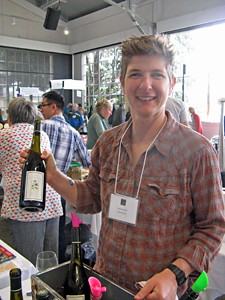 |
Located in the Boonville area, Pennyroyal Farm was established in 2012 and specializes in both wine from their estate vineyard and cheese from their goats and sheep. The vineyard is planted to 7 acres of Sauvignon Blanc and 15 acres of Pinot Noir. A sister winery of Navarro Vineyards, Sarah Cahn Bennett is the Pennyroyal Farm co-owner and winemaker. She was on hand to pour her wines at Taste of Mendocino. I had visited the Pennyroyal Farm tasting room in August 2017 – where I was impressed by many of the wines – and I focused this time on a couple of wines that were new releases since then. The 2016 Sauvignon Blanc was a standout, with bright citrus and herb aromas plus floral undertones, a medium-light texture and lively, slightly chalky finish. This was my favorite of several very good Sauvignon Blancs of the day – distinctly herbal without being overly grassy. The 2015 Hammer Olsen Chardonnay was also noteworthy, showing leesy citrus and apple scents along with earth and spice, with a bright mouthfeel and long finish.
Powicana Farm
With their first vintage coming in 2013, Powicana Farm was one of the newer wineries at the tasting. Husband-and-wife proprietors Remi and Zoubeida Zajac, originally from France, work exclusively with Petite Sirah from their biodynamically-farmed vineyard in Redwood Valley. They produce everything from a rosé to a Port-style wine from their fruit. Remi and Zoubeida poured four wines for me and I thought two of them were standouts. The 2017 Pétillant Naturel Petite Sirah was a pleasant surprise – not a variety you usually think of for a pét-nat. This displayed bright wild berry fruit with floral undertones, vibrant acidity and a lightly sparkling texture. The 2015 Estate Petite Sirah was another winner, with blueberry, black pepper, flowers, and spice on the nose, fine acidity, and refined tannins. Very good showing for this Petite Sirah specialist.
Tahto Wines
Tahto is the label of Wayne Bauer and Anne McAfee, who purchased property in Potter Valley in the late 1990s and planted Sauvignon Blanc there. Wayne has been making wine since the early 1980s and sources fruit for the Tahto wines from nearby Ukiah Valley and Redwood Valley as well as Potter Valley. The 2017 Rosé, sourced from Trails End Vineyard in Potter Valley, was my favorite wine from Tahto. Mostly from Grenache Noir plus a little Syrah, this featured bright red fruits, spice, and a floral note, with a refreshing mouthfeel and finish. Also noteworthy was the 2014 Piffero Vineyard Zinfandel, from Redwood Valley – ripe, spicy, and peppery wild berry and darker fruit, with touches of earth and vanilla/oak, good structure, and firm tannins.
Testa Vineyards
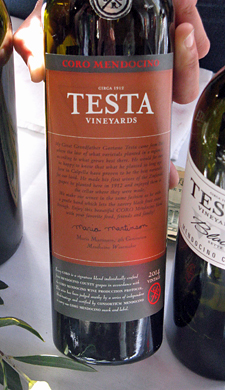 |
Winemaker Maria Testa Martinson’s great-grandparents Gaetano and Maria Testa first planted their family’s vineyard in Calpella near Redwood Valley in 1912. It’s planted to Carignane, Petite Sirah, Zinfandel, Barbera, Grenache, and Charbono. Although the family has farmed winegrapes for over a century, they only began making their own commercial wines relatively recently. I enjoyed several wines at the Testa table – the first was the NV “White”, which is a blend of Chardonnay and Sauvignon Blanc plus a little Viognier, made entirely in stainless steel. This was bright and fruit-forward, with floral and herbal notes and a clean finish. The 2013 “Old Vine” Zinfandel featured bold blueberry, herbs, earth, and pepper aromas with medium weight and fine tannins. The standout Testa wine was their 2014 “Coro Mendocino” – 40% Zinfandel, 30% Carignane, 25% Charbono, and 5% Petite Sirah. Part of the Coro Mendocino program that a number of the county’s wineries participate in, this was earthy, spicy, and peppery, with less upfront fruit than the “Old Vine” Zin but a more complex wine. Good structure and moderately tannic, this should develop nicely over the next few years.
Theopolis Vineyards
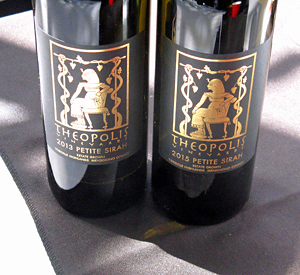 |
Theodora Lee is an attorney who also owns and farms her own vineyard in the Yorkville Highlands region of Mendocino County – her nickname is Theo-patra, Queen of the Vineyards! She planted her five-acre vineyard – all Petite Sirah – in 2003 and has sold fruit to producers including Carlisle, Halcón, and Highlawn. She began producing wine under her own label with the 2012 vintage. As usual, Theodora was behind her table at the event, and I thought several of her wines were noteworthy. The 2016 Estate Rosé of Petite Sirah was made by direct press, and featured black cherry and spice aromas with floral undertones, and a bright, refreshing texture and finish – showing that even Petite Sirah can make a pleasant rosé. The 2015 Estate Petite Sirah displayed dark berry fruit, flowers, and pepper on the nose, with lots of structure and a grippy tannic finish – a promising young Petite but it needs time. Showing what a little bottle age can do was the 2013 Estate Petite Sirah, which had beautiful aromatics of blueberry, earth, flowers, and touches of black pepper and stony minerals, along with a big but refined structure and finish – ready to drink now and with aging potential too.
Waits-Mast Family Cellars
Jennifer Waits & Brian Mast established their winery in 2005, and they focus mainly on Pinot Noir sourced from Anderson Valley, Mendocino Ridge, and Comptche. The wines are made in San Francisco, and use destemmed fruit fermented with native yeast and typically aged in 25-30% new French oak. Shalini Sekhar is the consulting winemaker. (Disclosure – I’ve helped out with bottling for Waits-Mast) Both Jennifer and Brian were there to pour their wines at the tasting, and I particularly enjoyed three of the wines I tried. The 2017 Sauvignon Blanc, from Mariah Vineyard on Mendocino Ridge, was bright and lightly herbal, displaying citrus fruit and floral aromas, with fine acidity and a crisp finish. The 2015 Mendocino County Pinot Noir includes fruit from Mariah and Oppenlander vineyards – this showed black cherry, herbs, tea leaf, and floral undertones with a lively texture and finish. I finished with the 2014 Oppenlander Vineyard Pinot Noir, which featured a darker fruit profile plus more spice and earth character and a savory note, with a more structured mouthfeel and firmer tannins – a good candidate for a few years in the cellar.
|


